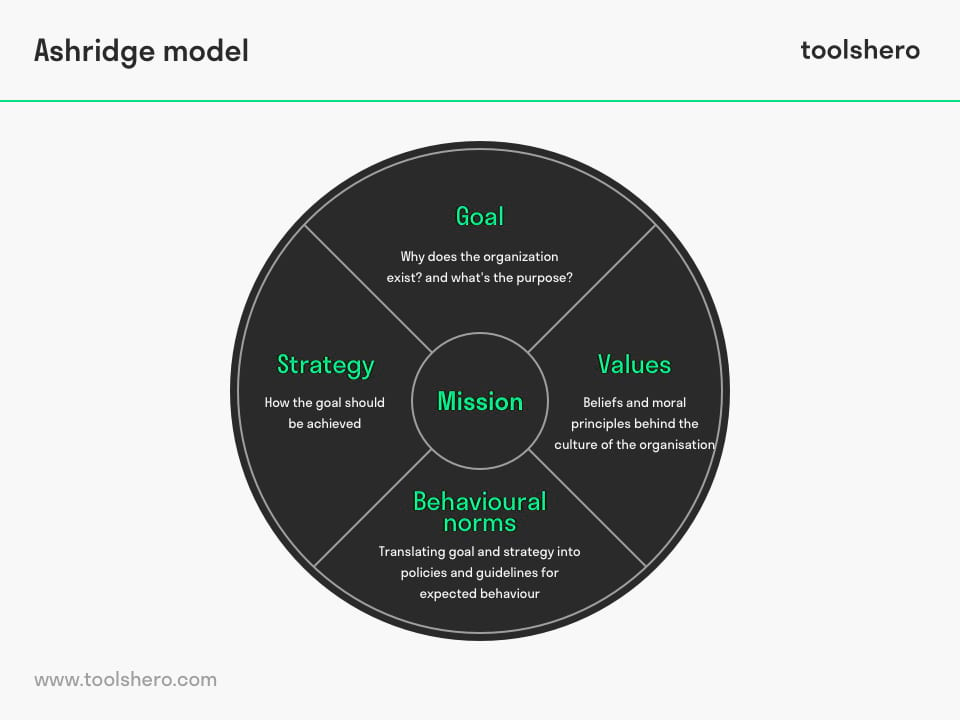Ashridge Model

Ashridge Model: this article provides a practical explanation of the Ashridge Model. After reading, you’ll understand the basics of this powerful strategy tool.
What is the Ashridge Model?
The Ashridge Model is a framework and tool for drawing up a mission statement. It includes four dimensions for mission statements, namely strategy, values, behavioural norms, and goals.
The values and behavioural norms dimensions are metaphysical concepts. They are intended to describe an organisation’s culture.
On the other hand, there are also strategic and cultural aspects. The strategical aspect can be considered an important step within strategic management. The cultural aspect can be seen as a means to encourage cooperation between employees.
An organisation’s mission is stronger and more achievable when the four elements of this model are connected to each other.
Creating an organisational mission is a complex activity, and there is often a lack of clarity about what needs to be included. Given this degree of confusion, Andrew Campell and Yeung conducted a two-year study in the early 1990s. Fifty-three successful organisations were asked to design a meaningful mission structure. The fruits of this research have become the framework known as the Ashridge Mission Model.
Purpose of a mission statement
First of all, a mission statement consists of a description of why the organisation exists—i.e. what its purpose is. Many organisations have difficulty describing this aspect. The authors of the Ashridge model found three types of organisations, with each type having a similar kind of purpose.
Types of organisations
First, there are organisations that focus exclusively on creating value for shareholders. Decisions made in these types of organisations are all made from the perspective of the owners.
Second, there are organisations that focus on satisfying the interests of all stakeholders. These organisations are generally very responsible towards stakeholders such as customers, employees, and the environment. An example is an altruistic organisation.
Third, there are the organisations that strive for an ideal. These organisations are aware of the interests of stakeholders, but focus primarily on achieving a higher moral goal.
Values in a mission statement
Values are the principles and beliefs that underlie the corporate culture, an important part of any organisation. Values give meaning to the behavioural norms in the company, and act similar to the ID in the human brain.
The company’s professional code of conduct only allows the employee to serve the customer in the best possible way. Naturally, there is also a commercial motive, but the moral conviction is stronger. Company values are not explicitly included in every organisation.
An example where values and mission statements can provide an extra incentive for certain behaviours comes from the Hewlett-Packard (HP) company.
While working for HP, Tom Peters developed the so-called ‘HP way’; a behavioural standard described in the book In Search of Excellence: Management by Wandering Around.
Behavioural Norms in Organisations
The behavioural norms are often the core values of an organisation translated into behavioural guidelines. This makes it clear which behaviour is expected from employees.
This may involve fairly abstract concepts, from customer-friendliness to concrete instructions for accompanying the customer in the store.
Behavioural norms are often also laid down in, for example, a code of conduct. These include expectations and principles, social norms, rules, and conventional principles.
Strategy and mission
To achieve organisational objectives in a competitive environment, a good strategy must be pursued. A strategy offers a commercial guide for the entire company.
When it comes to an organisation that aims to be the best in its industry, it must be possible to deduce from the strategy why the company will become the best.
Read more about brand positioning and brand management. If the goal is to generate a lot of profit, the company must explain how it will create this wealth.
Ashridge Model: essential Functions of a mission statement
According to the Ashridge model, a good mission must relate to the four elements explained above. Only then will the mission be inspiring and provide direction for employees.
Below are several examples of elements that appear in a good mission statement.
Target group
Many smaller commercial businesses solve consumer problems by offering solutions. It is important that a market-oriented mission statement reflects the needs of the customer and target group.
Contributions
From the mission statement, it must also be possible to deduce with which product or service the organisation will enter the market. Which products and services are offered, and why exactly do customers want these products or services?
Distinctiveness
In many industries, competition is fierce and it is therefore important that the product or service is unique and clearly adds value. This is important, because consumers can naturally choose from several options, and all organisations desire new customers.
After developing the mission statement, ask yourself the following questions:
- Is the mission statement motivating?
- Is the mission statement realistic?
- Is the mission statement specific, short, and easy to remember?
- Is the mission statement focused on satisfying the wishes of the customer?
- Does the mission statement reflect our customers?
- Does the mission statement describe how the organisation approaches customers?
- Is the mission statement based on core values or competences?
Advantages and disadvantages of a mission statement / using the Ashridge model
The fact that the 53 organisations from the study conducted by the authors of the Ashridge model had difficulty drawing up a mission statement is not that surprising.
After all, it is a complex task—and very important. This is partly because mistakes can easily be made. There are of course both advantages and disadvantages to using the Ashridge model and drawing up a mission statement.
Advantages of the Ashridge Model
A mission statement provides guidance and is an efficient method to keep the organisation on the right track. Without a mission statement, an organisation would become directionless, and the organisation would struggle to make decisions for the future.
Naturally, a mission statement also gives the organisation a general goal. Stakeholders such as shareholders want to be kept informed of business activities and decisions that are made to pursue the objectives.
Disadvantages of the Ashridge Model
In many cases, a mission statement is not realistic or feasible. The authors of the Ashridge model also noticed this. Overly positive statements were particularly seen.
An unrealistic mission statement may also adversely affect the behaviour and performance of employees. This is because the unrealistic objectives cannot be achieved in the future, and employees will therefore not experience any success.
A good mission statement always requires time and planning. The time and effort put into creating a mission statement makes it an expensive activity.
If mission statements and objectives are not achieved (e.g. due to overly positive prospects), the entire process can pretty much be considered useless.
Now It’s Your Turn
What do you think? Are you familiar with the explanation of the Ashridge model? Do you see similarities between good mission statements and the aspects described in this model? What else is important to consider when drawing up mission and vision statements? Do you have any tips or additional comments?
Share your experience and knowledge in the comments box below.
More information
- Campbell, A., & Yeung, S. (1991). Creating a sense of mission. Long range planning, 24(4), 10-20.
- Davies, S. W., & Glaister, K. W. (1996). Spurs to higher things? Mission statements of UK universities. Higher Education Quarterly, 50(4), 261-294.
- Davies, S. W., & Glaister, K. W. (1997). Business school mission statements—the bland leading the bland?. Long Range Planning, 30(4), 481-604.
- Salem Khalifa, A. (2012). Mission, purpose, and ambition: redefining the mission statement. Journal of Strategy and Management, 5(3), 236-251.
How to cite this article:
Janse, B. (2019). Ashridge Model. Retrieved [insert date] from Toolshero: https://www.toolshero.com/strategy/ashridge-model/
Published on: 11/01/2019 | Last update: 05/12/2022
Add a link to this page on your website:
<a href=”https://www.toolshero.com/strategy/ashridge-model/”>Toolshero: Ashridge Model</a>













